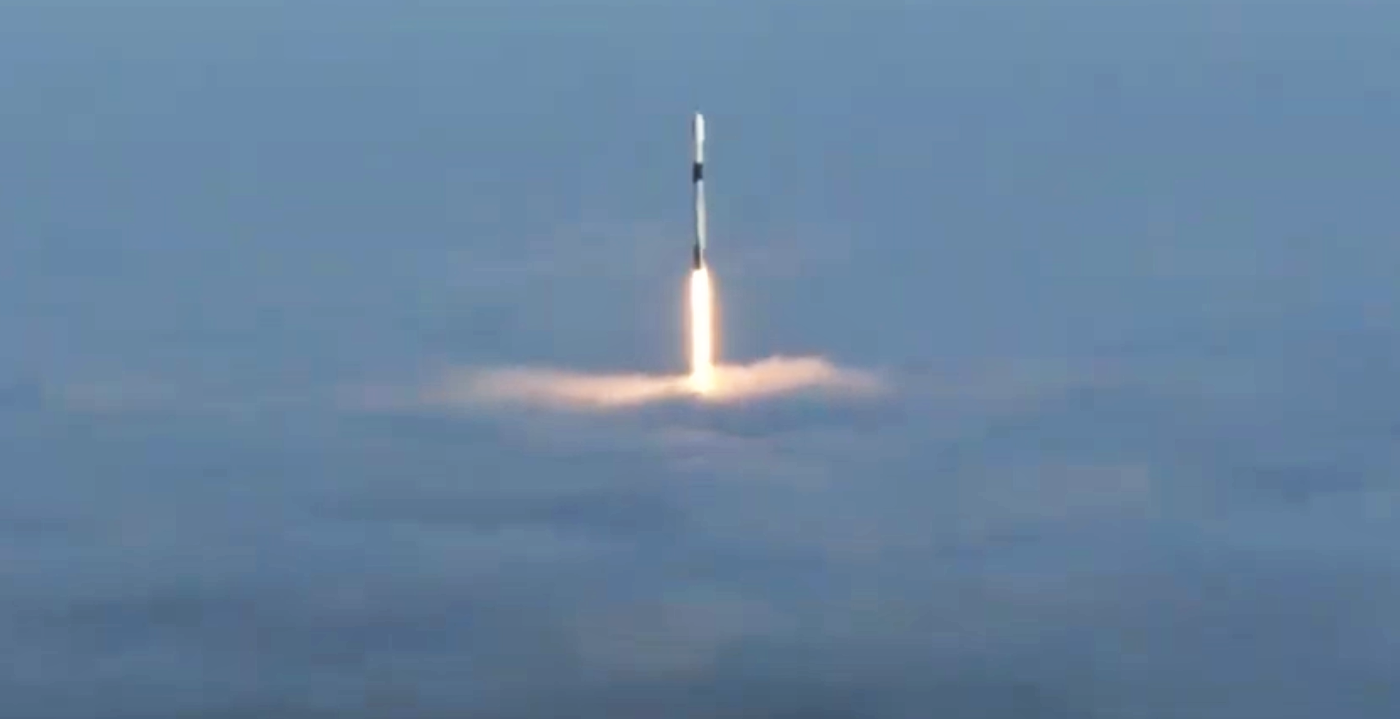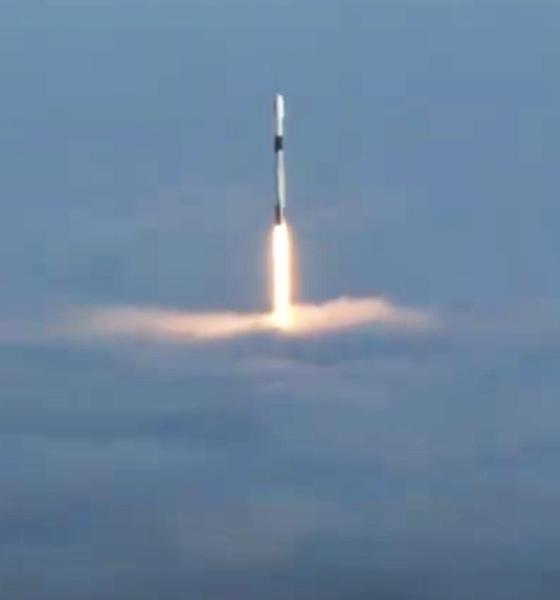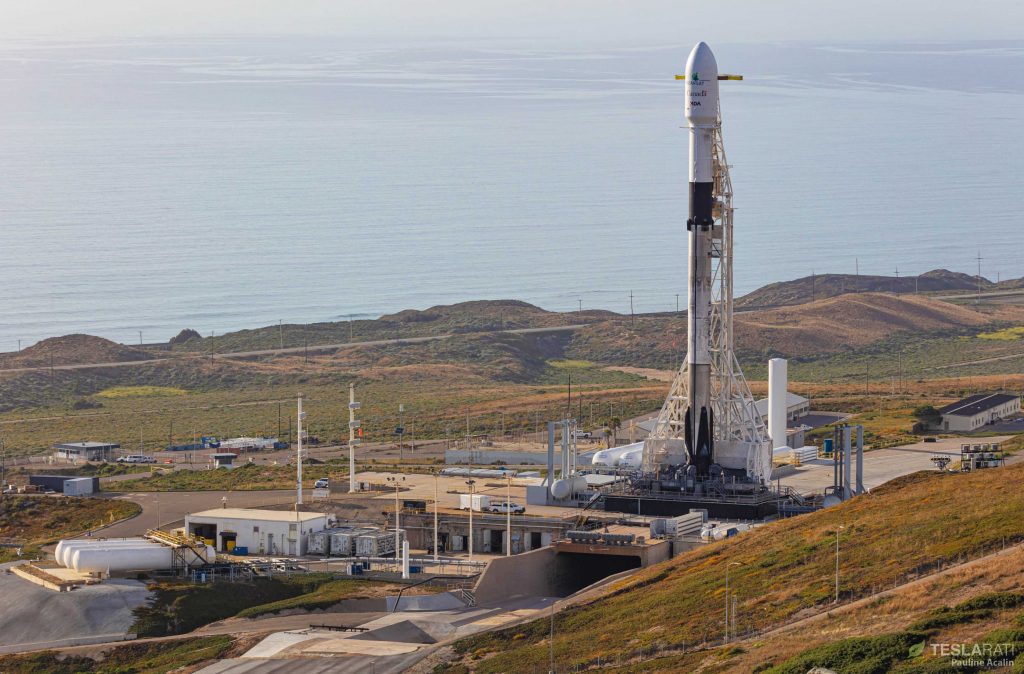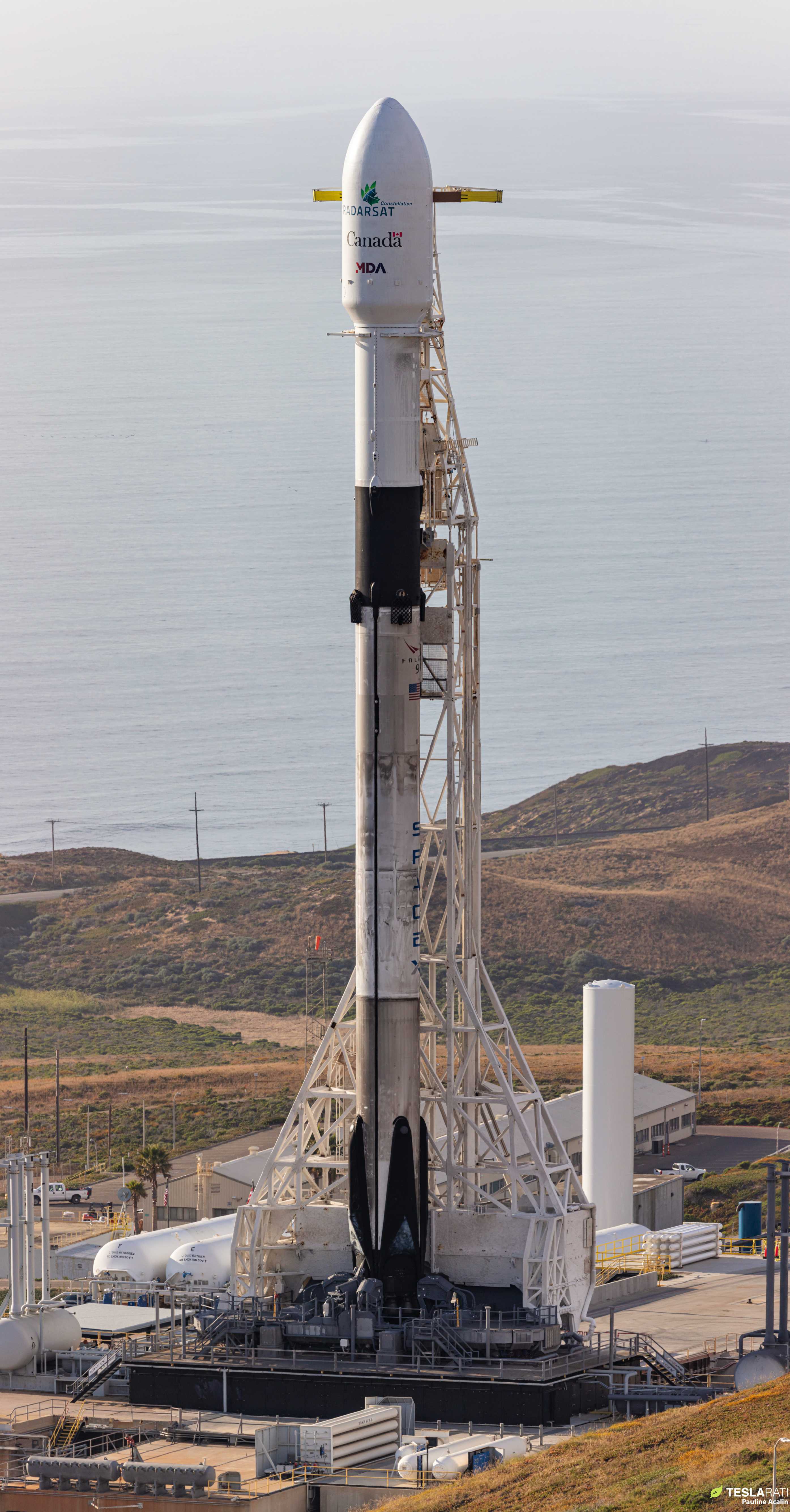

News
SpaceX’s Falcon 9 sticks foggy booster recovery at California landing zone
Update: SpaceX has successfully wrapped up the Radarsat Constellation Mission, likely its last launch from Vandenberg Air Force Base for six to nine months. Supporting its second mission, Falcon 9 booster B1051 completed a flawless launch and landing, returning to SpaceX’s pad-adjacent LZ-4 landing zone after a gentle, (relatively) low-velocity reentry at ~1.6 km/s (3700 mph).
Sadly, the sun was unable to beat back Vandenberg’s iconic fog layer and it’s unlikely that remote cameras (even including SpaceX’s own on-pad webcast cameras) captured anything more than gray fog. According to Teslarati’s photographers, the sonic booms produced by the returning Falcon 9 booster were as spectacular as ever, though.
Despite more than seven months of delays, the Canadian Space Agency (CSA) can finally rest now that all three Radarsat Constellation spacecraft are safely in orbit, completing what is arguably the most arduous leg of most spacecraft journeys. Valued at more than $1 billion, SpaceX has also successfully launched its most expensive payload by a large margin, adding to Falcon 9’s increasingly impressive record of reliability.




SpaceX is just hours away from its sixth Falcon 9 launch of 2019, likely the company’s last Vandenberg Air Force Base (VAFB) mission for the rest of the year (and possibly longer).
Flight proven Falcon 9 booster B1051.1 has been assigned to the launch and will attempt to return to SpaceX’s LZ-4 landing zone after sending Canada’s Radarsat Constellation Mission (RCM) on its way to orbit. Likely weighing approximately 5000 kg (11,000 lb), RCM is comprised of a trio of Earth observation spacecraft with large surface-scanning radars as their primary payloads. At a cost of more than $1 billion, RCM will be the most expensive payload SpaceX has ever attempted to launch. Falcon 9 has a 13-minute window for launch but liftoff is scheduled to occur at 7:17 am PDT (14:17 UTC) on Wednesday, June 12th.
As it stands, Falcon 9’s RCM launch will last just over one hour from start to finish. B1051 will separate from Falcon 9’s upper stage, fairing, and payload and perform a return-to-launch-site (RTLS) recovery, landing at SpaceX’s LZ-4 pad less than eight minutes after liftoff.

LZ-4 sits barely a quarter of a mile away from SLC-4E, the SpaceX-leased pad that B1051.1 will lift off from. Sadly, B1051 is unlikely to remain at SLC-4 after its (hopefully successful) landing at LZ-4 due to the fact that SpaceX has no public missions scheduled to launch from VAFB until Q1 2020 at the earliest. In fact, SpaceX is reportedly planning major organizational changes – set to begin soon after this launch is complete. As such, RCM could be SpaceX’s last launch from California for at least the next six months, a period of downtime that could easily grow to a year or more if tenuous 2020 launch dates suffer payload-side delays.
SpaceX currently has three launches scheduled from its Vandenberg pad in 2020, although one, two, or even all three could easily slip into 2021 based on the limited information available about the payloads in question. In 2021, SpaceX has a fairly busy VAFB manifest of at least six possible launches – possibly more if 2020 missions slip.
Regardless, RCM will be a good temporary send-off to SpaceX’s launch activity in California. Press photographers – unaffiliated with SpaceX – will have the first opportunity ever to remotely capture images of a Falcon 9 booster landing in daylight. Additionally, weather permitting, Vandenberg Air Force Base makes for an exceptionally beautiful venue for rocket launches thanks to the vistas and setting offered by Northern California and the Pacific Ocean.
Current forecasts suggest that the traditional fog layer will begin to clear at 7am local time, around the same time that SpaceX’s RCM webcast will kick off. With any luck, the photographers’ remote cameras will be greeted by a clear Pacific morning come liftoff.


Check out Teslarati’s Marketplace! We offer Tesla accessories, including for the Tesla Cybertruck and Tesla Model 3.

News
Tesla FSD v14.2.2 is getting rave reviews from drivers
So far, early testers have reported buttery-smooth drives with confident performance, even at night or on twisty roads.

Tesla Full Self-Driving (Supervised) v14.2.2 is receiving positive reviews from owners, with several drivers praising the build’s lack of hesitation during lane changes and its smoother decision-making, among others.
The update, which started rolling out on Monday, also adds features like dynamic arrival pin adjustment. So far, early testers have reported buttery-smooth drives with confident performance, even at night or on twisty roads.
Owners highlight major improvements
Longtime Tesla owner and FSD user @BLKMDL3 shared a detailed 10-hour impression of FSD v14.2.2, noting that the system exhibited “zero lane change hesitation” and “extremely refined” lane choices. He praised Mad Max mode’s performance, stellar parking in locations including ticket dispensers, and impressive canyon runs even in dark conditions.
Fellow FSD user Dan Burkland reported an hour of FSD v14.2.2’s nighttime driving with “zero hesitations” and “buttery smooth” confidence reminiscent of Robotaxi rides in areas such as Austin, Texas. Veteran FSD user Whole Mars Catalog also demonstrated voice navigation via Grok, while Tesla owner Devin Olsen completed a nearly two-hour drive with FSD v14.2.2 in heavy traffic and rain with strong performance.
Closer to unsupervised
FSD has been receiving rave reviews, even from Tesla’s competitors. Xpeng CEO He Xiaopeng, for one, offered fresh praise for FSD v14.2 after visiting Silicon Valley. Following extended test drives of Tesla vehicles running the latest FSD software, He stated that the system has made major strides, reinforcing his view that Tesla’s approach to autonomy is indeed the proper path towards autonomy.
According to He, Tesla’s FSD has evolved from a smooth Level 2 advanced driver assistance system into what he described as a “near-Level 4” experience in terms of capabilities. While acknowledging that areas of improvement are still present, the Xpeng CEO stated that FSD’s current iteration significantly surpasses last year’s capabilities. He also reiterated his belief that Tesla’s strategy of using the same autonomous software and hardware architecture across private vehicles and robotaxis is the right long-term approach, as it would allow users to bypass intermediate autonomy stages and move closer to Level 4 functionality.
News
Elon Musk’s Grok AI to be used in U.S. War Department’s bespoke AI platform
The partnership aims to provide advanced capabilities to 3 million military and civilian personnel.

The U.S. Department of War announced Monday an agreement with Elon Musk’s xAI to embed the company’s frontier artificial intelligence systems, powered by the Grok family of models, into the department’s bespoke AI platform GenAI.mil.
The partnership aims to provide advanced capabilities to 3 million military and civilian personnel, with initial deployment targeted for early 2026 at Impact Level 5 (IL5) for secure handling of Controlled Unclassified Information.
xAI Integration
As noted by the War Department’s press release, GenAI.mil, its bespoke AI platform, will gain xAI for the Government’s suite of tools, which enable real-time global insights from the X platform for “decisive information advantage.” The rollout builds on xAI’s July launch of products for U.S. government customers, including federal, state, local, and national security use cases.
“Targeted for initial deployment in early 2026, this integration will allow all military and civilian personnel to use xAI’s capabilities at Impact Level 5 (IL5), enabling the secure handling of Controlled Unclassified Information (CUI) in daily workflows. Users will also gain access to real‑time global insights from the X platform, providing War Department personnel with a decisive information advantage,” the Department of War wrote in a press release.
Strategic advantages
The deal marks another step in the Department of War’s efforts to use cutting-edge AI in its operations. xAI, for its part, highlighted that its tools can support administrative tasks at the federal, state and local levels, as well as “critical mission use cases” at the front line of military operations.
“The War Department will continue scaling an AI ecosystem built for speed, security, and decision superiority. Newly IL5-certified capabilities will empower every aspect of the Department’s workforce, turning AI into a daily operational asset. This announcement marks another milestone in America’s AI revolution, and the War Department is driving that momentum forward,” the War Department noted.
News
Tesla FSD (Supervised) v14.2.2 starts rolling out
The update focuses on smoother real-world performance, better obstacle awareness, and precise end-of-trip routing, among other improvements.

Tesla has started rolling out Full Self-Driving (Supervised) v14.2.2, bringing further refinements to its most advanced driver-assist system. The new FSD update focuses on smoother real-world performance, better obstacle awareness, and precise end-of-trip routing, among other improvements.
Key FSD v14.2.2 improvements
As noted by Not a Tesla App, FSD v14.2.2 upgrades the vision encoder neural network with higher resolution features, enhancing detection of emergency vehicles, road obstacles, and human gestures. New Arrival Options let users select preferred drop-off styles, such as Parking Lot, Street, Driveway, Parking Garage, or Curbside, with the navigation pin automatically adjusting to the user’s ideal spot for precision.
Other additions include pulling over for emergency vehicles, real-time vision-based detours for blocked roads, improved gate and debris handling, and extreme Speed Profiles for customized driving styles. Reliability gains cover fault recovery, residue alerts on the windshield, and automatic narrow-field camera washing for new 2026 Model Y units.
FSD v14.2.2 also boosts unprotected turns, lane changes, cut-ins, and school bus scenarios, among other things. Tesla also noted that users’ FSD statistics will be saved under Controls > Autopilot, which should help drivers easily view how much they are using FSD in their daily drives.
Key FSD v14.2.2 release notes
Full Self-Driving (Supervised) v14.2.2 includes:
- Upgraded the neural network vision encoder, leveraging higher resolution features to further improve scenarios like handling emergency vehicles, obstacles on the road, and human gestures.
- Added Arrival Options for you to select where FSD should park: in a Parking Lot, on the Street, in a Driveway, in a Parking Garage, or at the Curbside.
- Added handling to pull over or yield for emergency vehicles (e.g. police cars, fire trucks, ambulances).
- Added navigation and routing into the vision-based neural network for real-time handling of blocked roads and detours.
- Added additional Speed Profile to further customize driving style preference.
- Improved handling for static and dynamic gates.
- Improved offsetting for road debris (e.g. tires, tree branches, boxes).
- Improve handling of several scenarios, including unprotected turns, lane changes, vehicle cut-ins, and school buses.
- Improved FSD’s ability to manage system faults and recover smoothly from degraded operation for enhanced reliability.
- Added alerting for residue build-up on interior windshield that may impact front camera visibility. If affected, visit Service for cleaning!
- Added automatic narrow field washing to provide rapid and efficient front camera self-cleaning, and optimize aerodynamics wash at higher vehicle speed.
- Camera visibility can lead to increased attention monitoring sensitivity.
Upcoming Improvements:
- Overall smoothness and sentience.
- Parking spot selection and parking quality.








